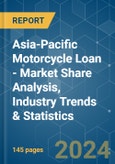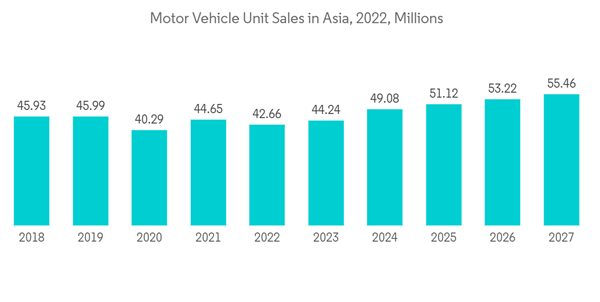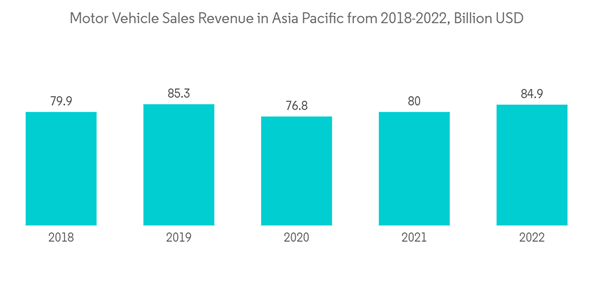Asia-Pacific Motorcycle Loan Market generated a revenue of USD 65 billion in the current year and is poised to achieve a CAGR of 10% for the forecast period.
The Asia-Pacific region is a significant and dynamic market for motorcycle loans. It encompasses diverse countries with economic conditions, consumer preferences, and regulatory environments. The Asia Pacific region represents a large and growing motorcycle market. Rapid urbanization, increasing disposable incomes, and population growth increase the demand for motorcycles and motorcycle loans. Countries such as China, India, Indonesia, Vietnam, and Thailand are among the key markets driving the growth of the motorcycle loan segment in the region. Economic conditions play a vital role in shaping the motorcycle loan market in the Asia-Pacific. Factors such as GDP growth rates, inflation, interest rates, and employment levels influence consumer confidence, affordability, and willingness to borrow. Favorable economic conditions, with stable growth and low-interest rates, can stimulate motorcycle sales and the demand for financing options.
The rising middle-class population and urbanization in many Asia-Pacific countries drive the motorcycle loan market. Motorcycles become popular as people migrate to cities and seek affordable transportation solutions. Motorcycle loans provide affordable financing, allowing individuals to purchase motorcycles for personal use or income-generating activities. Technology plays a significant role in the motorcycle loan market across the Asia-Pacific. Online loan application processes, digital documentation, and automated approval systems made it more convenient for borrowers to apply for motorcycle loans. Digital platforms and mobile applications also facilitated loan servicing and payment management, enhancing customer experience.
The pandemic disrupted global supply chains, affecting the production and distribution of motorcycles. Manufacturing facilities faced temporary closures, reducing the availability of new motorcycles in the market. The limited supply of motorcycles impacted the demand for motorcycle loans, as consumers needed more options to purchase. The economic uncertainty caused by the pandemic, including job losses, reduced incomes, and financial insecurity, led to decreased consumer confidence and spending. Many potential motorcycle buyers postponed or canceled their plans due to financial concerns. This decline in consumer spending directly affected the demand for motorcycle loans.
This product will be delivered within 2 business days.
The Asia-Pacific region is a significant and dynamic market for motorcycle loans. It encompasses diverse countries with economic conditions, consumer preferences, and regulatory environments. The Asia Pacific region represents a large and growing motorcycle market. Rapid urbanization, increasing disposable incomes, and population growth increase the demand for motorcycles and motorcycle loans. Countries such as China, India, Indonesia, Vietnam, and Thailand are among the key markets driving the growth of the motorcycle loan segment in the region. Economic conditions play a vital role in shaping the motorcycle loan market in the Asia-Pacific. Factors such as GDP growth rates, inflation, interest rates, and employment levels influence consumer confidence, affordability, and willingness to borrow. Favorable economic conditions, with stable growth and low-interest rates, can stimulate motorcycle sales and the demand for financing options.
The rising middle-class population and urbanization in many Asia-Pacific countries drive the motorcycle loan market. Motorcycles become popular as people migrate to cities and seek affordable transportation solutions. Motorcycle loans provide affordable financing, allowing individuals to purchase motorcycles for personal use or income-generating activities. Technology plays a significant role in the motorcycle loan market across the Asia-Pacific. Online loan application processes, digital documentation, and automated approval systems made it more convenient for borrowers to apply for motorcycle loans. Digital platforms and mobile applications also facilitated loan servicing and payment management, enhancing customer experience.
The pandemic disrupted global supply chains, affecting the production and distribution of motorcycles. Manufacturing facilities faced temporary closures, reducing the availability of new motorcycles in the market. The limited supply of motorcycles impacted the demand for motorcycle loans, as consumers needed more options to purchase. The economic uncertainty caused by the pandemic, including job losses, reduced incomes, and financial insecurity, led to decreased consumer confidence and spending. Many potential motorcycle buyers postponed or canceled their plans due to financial concerns. This decline in consumer spending directly affected the demand for motorcycle loans.
Asia-Pacific Motorcycle Loan Market Trends
Impact of Increasing Motor Vehicle Unit Sales
As motor vehicle sales, particularly car sales, increase, consumer preferences may shift towards car ownership. This shift can lead to a decrease in demand for motorcycles as a mode of transportation. Consequently, the demand for motorcycle loans may decline as consumers opt for car loans instead. Given the higher demand, financial institutions and lenders may prioritize financing options for motor vehicles. They may allocate more resources, marketing efforts, and competitive loan terms for car loans. It could result in fewer specialized motorcycle loan products or reduced promotional offers, impacting the accessibility and availability of motorcycle loans. Increasing unit sales of motor vehicles can lead to heightened competition among lenders to capture a larger share of the auto loan market. This competition may lead to more attractive loan terms and lower interest rates for car loans. In contrast, motorcycle loans may need more competitive terms or higher interest rates due to reduced demand and less focus from lenders.Motorcycle Revenue can Influence the Motorcycle Loan Market
Higher revenue from motorcycle sales indicates increased market demand for motorcycles. As more people purchase motorcycles, the demand for motorcycle loans may also rise. Consumers may seek financing options to purchase motorcycles, particularly for higher-priced models, or when they prefer spreading out the cost over time. Increased motorcycle revenue can stimulate loan demand and drive the growth of the motorcycle loan market. The revenue generated from motorcycle sales can directly impact the performance of lenders' motorcycle loan portfolios. If motorcycle sales revenue is strong and sustained, it indicates a healthy market with potential repayment capacity for borrowers. It can contribute to a lower risk profile for motorcycle loans, leading to more favorable lending terms and interest rates for borrowers. Lenders may be more inclined to offer competitive loan products and expand their motorcycle loan portfolios with robust revenue.Asia-Pacific Motorcycle Loan Industry Overview
The motorcycle loan market in Asia-Pacific is highly competitive, with various financial institutions, banks, and non-banking financial companies (NBFCs) offering loan products. Lenders strive to attract customers by providing competitive interest rates, flexible repayment options, and value-added services. The competitive landscape of the Asia-Pacific motorcycle loan industry is diverse and consists of various financial institutions, lenders, and automotive financing companies. The competition encourages innovation and customization of loan products to cater to customers' needs. Monitoring market developments, industry reports, and customer feedback can provide insights into the evolving competitive landscape in the Asia Pacific motorcycle loan industry. Following is the list of companies in the market: Ford Motor Credit Company, Toyota Financial Services, China International Capital Corporation, Citi Bank, and Mitsubishi HC Capital Asia PacificAdditional Benefits:
- The market estimate (ME) sheet in Excel format
- 3 months of analyst support
This product will be delivered within 2 business days.
Table of Contents
1 INTRODUCTION
4 MARKET DYNAMICS AND INSIGHTS
5 MARKET SEGMENTATION
6 COMPETITIVE LANDSCAPE
Methodology

LOADING...










